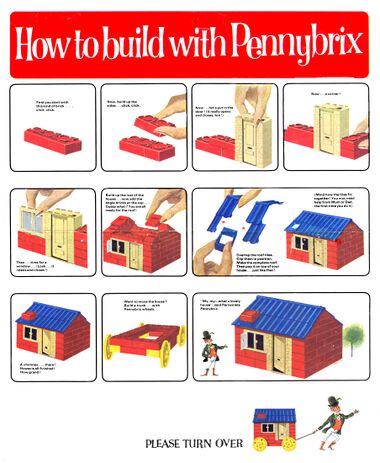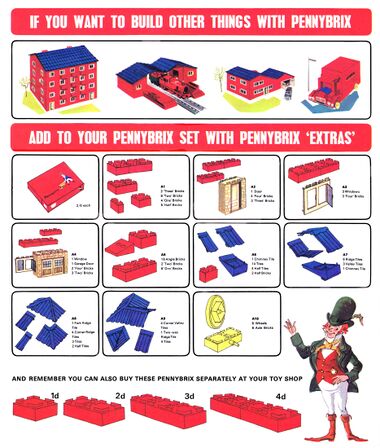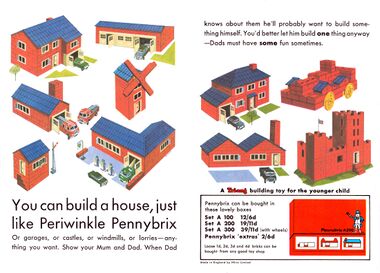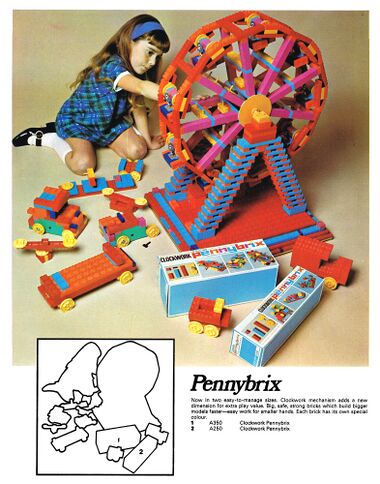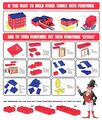Category:Pennybrix
| Toy Brands and Manufacturers |
|---|
Pennybrix |
| 1964 - |
1960s: "How to build with Pennybrix" [image info]
1960s: Pennybrix "Extras" [image info]
1960s: "You can build a house, just like Periwinkle Pennybrix" [image info]
1970: Clockwork Pennybrix [image info]
The Pennybrix plastic bricks system was introduced by Tri-ang in around 1964, as an attempt to produce a more "Lego-like" system.
Aimed at younger children, the four most basic individual Pennybrix pieces were available from toyshops separately, with a standard "one unit" piece – the counterpart of a square Lego "four by four" brick – costing exactly one penny (the others costing 2d, 3d and 4d for the 2,3, and four-unit bricks).
Periwinkle Pennybrix
In order to make the Pennybrix system more attractive to children, Tri-ang invented the Periwinkle Pennybrix character, who was supposed to live in a house built using Pennybrix.
Periwinkle had white trousers, yellow boots, a red waistcoat, blue jacket and blue top hat with a feather, and Periwinkle figures were included in some of the sets.
The instruction leaflet for how to use Pennybrix was called "Periwinkle Builds a House", and was illustrated in colour like a children's book, so that children could engage with the character and identify with Periwinkle building his house.
Toward the end of the product range's life, Periwinkle was joined by a second character, Mortimer Mole.
Description
Pennybricks were functionally similar to Lego bricks, with a hollow base and normally four or eight protrusions on the top surface to allow them to be clipped together, either as a column or with staggered offsets, just like Lego. The main difference with Pennybrix was that instead of four protruding "pegs", the bricks had four L-shaped protrusions towards the corners, which did roughly the same job.
Given the simplicity of the main bricks, the roof pieces were surprisingly sophisticated, with corrugated push-together tiles and half-tiles, spine tiles, joint pieces and concave "valley" angle tiles to allow roof sections that intersected at 90 degrees.
Colours
Main bricks were red, corrugated push-together roof tiles were blue, doorways and windows were tan stone-coloured, and wheels and axle blocks were yellow.
Main sets
- A 100 –
- A 200 –
- A 300 –
- A 400 –
At some point these seem to have been joined by a Periwinkle Road and Railway Set, with a red locomotive and clip-together track with channels for the wheels to run in.
~1970: Clockwork Pennybrix
By the time of the 1970 Rovex Triang trade catalogue, the range seems to have been simplified to two "Clockwork Pennybrix" sets.
- A 250 – Clockwork Pennybrix
- A 350 – Clockwork Pennybrix
"Extras" sets
- A1 – 2 "Three" Bricks, 8 "Two" Bricks, 4 "One" Bricks, 5 "Half" Bricks
- A2 – 1 Door, 4 "Four" Bricks, 3 "Three" Bricks
- A3 – 3 Windows, 3 "Four" Bricks
- A4 – 1 Window, 1 Garage Door, 2 "Four" Bricks, 3 "Two" Bricks
- A5 – 16 Angle Bricks, 2 "Two" Bricks, 8 "One" Bricks
- A6 – 1 Chimney Tile, 14 Tiles, 4 Half Tiles, 2 Half Bricks
- A7 – 6 Ridge Tiles, 3 Valley Tiles, 1 Chimney Tile
- A8 – 1 Fork Ridge Tile, 4 Corner Ridge Tiles, 3 Tiles, 2 Half Tiles
- A9 – 4 Corner Valley Tiles, 1 Two-Way Ridge Tile, 4 Tiles
- A10 – 6 Wheels, 6 Axle Bricks
External links
Pages in category ‘Pennybrix’
The following 2 pages are in this category, out of 2 total.
Media in category ‘Pennybrix’
The following 6 files are in this category, out of 6 total.
- Clockwork Pennybrix sets A250 A350 (RovexTC 1970).jpg 1,570 × 2,000; 2.21 MB
- How To Build With Pennybrix (PBAH).jpg 1,806 × 2,200; 1.54 MB
- Pennybrix Extras (PBAH).jpg 1,867 × 2,200; 1.95 MB
- Periwinkle Builds A House, front cover, Pennybrix (PBAH).jpg 1,516 × 2,200; 1.16 MB
- Periwinkle Pennybrix (PBAH).jpg 1,053 × 1,600; 463 KB
- You Can Build A House, Pennybrix (PBAH).jpg 2,200 × 1,582; 1.62 MB
